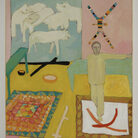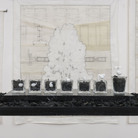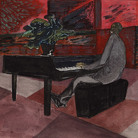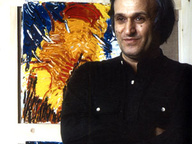Italian Pavilion – Public Program. Mondo Novo

Italian Pavilion – Public Program. Mondo Novo, Teatrino di Palazzo Grassi, Venezia
Dal 20 May 2023 al 24 November 2023
Venezia
Luogo: Teatrino di Palazzo Grassi
Indirizzo: San Marco 3260
Sito ufficiale: http://www.palazzograssi.it
Five dates to reflect on the crucial issues facing architecture today
curated by Fosbury Architecture
in collaboration with Palazzo Grassi – Punta della Dogana, Pinault Collection
with the support of Bottega Veneta
First event, Saturday, May 20, 2023, from 5pm to 8pm
Paradigms
Two-part encounter to discuss the necessity for the architect, in a constantly changing world, to avoid using classical tools: changing the paradigms of the discipline to imagine the architecture of the future.
Speakers:
Fosbury Architecture, all of the practices participating in the Italian Pavilion, Humboldt Books (publishing house), Giga Design Studio (design agency)
with
Markus Bader (raumlabor, architecture collective), Natalie Donat Cattin (architect, EPFL researcher, lecturer at ETH), Scott Lloyd (TEN Studio, architecture collective), Charlotte Malterre-Barthes (architect and EPFL researcher), Maria Vittoria Marini Clarelli (Director, Unit III – Contemporary Architecture, DGCC), Anna Puigjaner (lecturer and co-founding architect of MAIO, architectural firm), Mirko Zardini (architect, critic, curator)
To follow:
Friday, June 9, 2023 | Buildings
Friday, September 22, 2023 | Ecologies
Friday, October 20, 2023 | Economies
Friday, November 24, 2023 | Masters
Five dates to reflect on the crucial issues facing architecture today, with some of the most important and innovative protagonists on the international scene: this is Mondo Novo, the Public Program of the Italian Pavilion at the 18th International Architecture Exhibition – La Biennale di Venezia promoted by the Directorate-General for Contemporary Creativity of the Ministry of culture, which will take place at the Grassi Theater, Venice, between May 20 and November 26, 2023.
Mondo Novo, curated by Fosbury Architecture in collaboration with Palazzo Grassi – Punta della Dogana, Pinault Collection, has been organized with the support of Bottega Veneta.
The title, Mondo Novo, refers to Giandomenico Tiepolo’s painting of the same name, painted by the Venetian artist in 1791, between the French Revolution and the fall of the Venice Republic, La Serenissima, at a time of instability that heralded great changes.
In the painting, a crowd of people can be seen from the back, huddled together, trying to squeeze forward as best they can to see what is happening far off toward the horizon. Using a formal device, Tiepolo implements a reversal of representation: the thronging crowd in the foreground prevents us from seeing what is behind them, hidden by their bodies, and the frenzy of the characters becomes the real protagonist of the composition. The painting portrays a feeling of deep unease and of the imminent end of an era: a sense of trepidation that seems the same as what we are experiencing today, given the profoundly changing world in which we live. Like the protagonists in the painting, we, too, are trying to gaze far into the distance, contemplating the horizon in search of some clues to help us decipher the future, in the hope that it will be a space in which “Everyone belongs to everyone else.”[1]
“The global upheavals of the past two decades have produced obvious repercussions for our profession – underlines Fosbury Architecture – if the season of architectural exuberance ended with the financial crisis of 2007-2008, the pandemic intensified the widespread awareness of total resource depletion. This shift in boundary conditions, instead of helping us close ranks, produced a strategic retreat. As Rory Hyde suggests in Future Practice: ‘All of these crises have spatial consequences that architects are well prepared to confront, and yet instead of diving in, we seem to be having our own crisis: a crisis of relevance.’ The obvious risk is that yet another internal discourse within the discipline will make us lose sight of how architecture, rather than being a solution, is often part of the problem.”
The simple interpolation of easily accessible data gives us a distinct picture of the state of the art.
On the one hand, the construction sector is globally responsible for 39% of the amount of carbon dioxide released into the atmosphere, 36% of electricity consumption, 50% of raw material extraction, and 33% of potable water consumption. On the other hand, especially in Italy, increasing land consumption is matched by a tightening market and chronic dissatisfaction among those in the industry. An inversely proportional relationship between growth and development that sets the stage for an unprecedented alliance between the environment and practitioners.
In the five Mondo Novo events, the invited guests will attempt, together with the curators and the Pavilion’s leading designers and advisors, to delineate possible lateral trajectories for the practice.
Each event will have a central theme, revolving around a series of discussions between different generations of individuals and practices from both the discipline and other fields of science and creativity, with the common goal of codifying new languages to describe and address contemporary challenges.
Five themes for five events: paradigms, buildings, ecologies, economies, masters. Five issues that have always been present in the debates within the discipline but that need constant updating of their meaning.
On May 20, 2023, the first event will be dedicated to Paradigms.
“When paradigms change, the world itself changes with them. Led by a new paradigm, scientists adopt new instruments and look in new places. Even more important, during revolutions scientists see new and different things when looking with familiar instruments in places they have looked before.” Thomas S. Kuhn, The Structure of Scientific Revolutions, 1962
For an architect, not using classical tools can be as destabilizing as not using words to express oneself, yet, as always, it is in the disorientation that paradigms change. Not seeing architecture in a project does not mean that it is devoid of one, but simply that the observer is not yet ready to recognize and describe it.
From 5:00pm to 6:00pm, in the foyer of the Teatrino Grassi, the architect, EPFL researcher, and ETH lecturer Natalie Donat Cattin will moderate a conversation entitled Toward an Alternative Architecture that will include Markus Bader, member of the architecture collective raumlabor, Scott Lloyd, member of the architecture collective TEN Studio, and the practices participating in the Italian Pavilion: an open dialogue between established or emerging collaborative practices, anchored in Italy or coming from other European contexts.
From 6:15pm to 8:00pm, inside the theater, after a short presentation of the Italian Pavilion as articulated by Maria Vittoria Marini Clarelli, Director, Unit III – Contemporary Architecture, DGCC, the Fosbury Architecture curators, the Humboldt Books publishing house, and the design agency Giga Design Studio, three prominent figures – from different generations and fields of research – will discuss their contributions to the Pavilion’s catalogue. Mirko Zardini will speak about the evolution of the discipline in relation to the successive crises that have occurred in the recent past; Anna Puigjaner will talk about what new communication tools there might be for architecture; and Charlotte Malterre-Barthes will discuss how professional practices should be rethought to be more ethical and empathetic.
[1] Spaziale. Everyone belongs to everyone else is the title chosen by Fosbury Architecture for the Italian Pavilion at the 18th International Architecture Exhibition – La Biennale di Venezia.
curated by Fosbury Architecture
in collaboration with Palazzo Grassi – Punta della Dogana, Pinault Collection
with the support of Bottega Veneta
First event, Saturday, May 20, 2023, from 5pm to 8pm
Paradigms
Two-part encounter to discuss the necessity for the architect, in a constantly changing world, to avoid using classical tools: changing the paradigms of the discipline to imagine the architecture of the future.
Speakers:
Fosbury Architecture, all of the practices participating in the Italian Pavilion, Humboldt Books (publishing house), Giga Design Studio (design agency)
with
Markus Bader (raumlabor, architecture collective), Natalie Donat Cattin (architect, EPFL researcher, lecturer at ETH), Scott Lloyd (TEN Studio, architecture collective), Charlotte Malterre-Barthes (architect and EPFL researcher), Maria Vittoria Marini Clarelli (Director, Unit III – Contemporary Architecture, DGCC), Anna Puigjaner (lecturer and co-founding architect of MAIO, architectural firm), Mirko Zardini (architect, critic, curator)
To follow:
Friday, June 9, 2023 | Buildings
Friday, September 22, 2023 | Ecologies
Friday, October 20, 2023 | Economies
Friday, November 24, 2023 | Masters
Five dates to reflect on the crucial issues facing architecture today, with some of the most important and innovative protagonists on the international scene: this is Mondo Novo, the Public Program of the Italian Pavilion at the 18th International Architecture Exhibition – La Biennale di Venezia promoted by the Directorate-General for Contemporary Creativity of the Ministry of culture, which will take place at the Grassi Theater, Venice, between May 20 and November 26, 2023.
Mondo Novo, curated by Fosbury Architecture in collaboration with Palazzo Grassi – Punta della Dogana, Pinault Collection, has been organized with the support of Bottega Veneta.
The title, Mondo Novo, refers to Giandomenico Tiepolo’s painting of the same name, painted by the Venetian artist in 1791, between the French Revolution and the fall of the Venice Republic, La Serenissima, at a time of instability that heralded great changes.
In the painting, a crowd of people can be seen from the back, huddled together, trying to squeeze forward as best they can to see what is happening far off toward the horizon. Using a formal device, Tiepolo implements a reversal of representation: the thronging crowd in the foreground prevents us from seeing what is behind them, hidden by their bodies, and the frenzy of the characters becomes the real protagonist of the composition. The painting portrays a feeling of deep unease and of the imminent end of an era: a sense of trepidation that seems the same as what we are experiencing today, given the profoundly changing world in which we live. Like the protagonists in the painting, we, too, are trying to gaze far into the distance, contemplating the horizon in search of some clues to help us decipher the future, in the hope that it will be a space in which “Everyone belongs to everyone else.”[1]
“The global upheavals of the past two decades have produced obvious repercussions for our profession – underlines Fosbury Architecture – if the season of architectural exuberance ended with the financial crisis of 2007-2008, the pandemic intensified the widespread awareness of total resource depletion. This shift in boundary conditions, instead of helping us close ranks, produced a strategic retreat. As Rory Hyde suggests in Future Practice: ‘All of these crises have spatial consequences that architects are well prepared to confront, and yet instead of diving in, we seem to be having our own crisis: a crisis of relevance.’ The obvious risk is that yet another internal discourse within the discipline will make us lose sight of how architecture, rather than being a solution, is often part of the problem.”
The simple interpolation of easily accessible data gives us a distinct picture of the state of the art.
On the one hand, the construction sector is globally responsible for 39% of the amount of carbon dioxide released into the atmosphere, 36% of electricity consumption, 50% of raw material extraction, and 33% of potable water consumption. On the other hand, especially in Italy, increasing land consumption is matched by a tightening market and chronic dissatisfaction among those in the industry. An inversely proportional relationship between growth and development that sets the stage for an unprecedented alliance between the environment and practitioners.
In the five Mondo Novo events, the invited guests will attempt, together with the curators and the Pavilion’s leading designers and advisors, to delineate possible lateral trajectories for the practice.
Each event will have a central theme, revolving around a series of discussions between different generations of individuals and practices from both the discipline and other fields of science and creativity, with the common goal of codifying new languages to describe and address contemporary challenges.
Five themes for five events: paradigms, buildings, ecologies, economies, masters. Five issues that have always been present in the debates within the discipline but that need constant updating of their meaning.
On May 20, 2023, the first event will be dedicated to Paradigms.
“When paradigms change, the world itself changes with them. Led by a new paradigm, scientists adopt new instruments and look in new places. Even more important, during revolutions scientists see new and different things when looking with familiar instruments in places they have looked before.” Thomas S. Kuhn, The Structure of Scientific Revolutions, 1962
For an architect, not using classical tools can be as destabilizing as not using words to express oneself, yet, as always, it is in the disorientation that paradigms change. Not seeing architecture in a project does not mean that it is devoid of one, but simply that the observer is not yet ready to recognize and describe it.
From 5:00pm to 6:00pm, in the foyer of the Teatrino Grassi, the architect, EPFL researcher, and ETH lecturer Natalie Donat Cattin will moderate a conversation entitled Toward an Alternative Architecture that will include Markus Bader, member of the architecture collective raumlabor, Scott Lloyd, member of the architecture collective TEN Studio, and the practices participating in the Italian Pavilion: an open dialogue between established or emerging collaborative practices, anchored in Italy or coming from other European contexts.
From 6:15pm to 8:00pm, inside the theater, after a short presentation of the Italian Pavilion as articulated by Maria Vittoria Marini Clarelli, Director, Unit III – Contemporary Architecture, DGCC, the Fosbury Architecture curators, the Humboldt Books publishing house, and the design agency Giga Design Studio, three prominent figures – from different generations and fields of research – will discuss their contributions to the Pavilion’s catalogue. Mirko Zardini will speak about the evolution of the discipline in relation to the successive crises that have occurred in the recent past; Anna Puigjaner will talk about what new communication tools there might be for architecture; and Charlotte Malterre-Barthes will discuss how professional practices should be rethought to be more ethical and empathetic.
[1] Spaziale. Everyone belongs to everyone else is the title chosen by Fosbury Architecture for the Italian Pavilion at the 18th International Architecture Exhibition – La Biennale di Venezia.
SCARICA IL COMUNICATO IN PDF
COMMENTI

-
 Dal 8 November 2025 al 11 January 2026
Venezia | Museo Correr
Dal 8 November 2025 al 11 January 2026
Venezia | Museo Correr
CARATTERI. Calligrafia e tipografia: Corea del Sud e Stati Uniti
-
 Dal 8 November 2025 al 22 February 2026
Brescia | Museo di Santa Giulia
Dal 8 November 2025 al 22 February 2026
Brescia | Museo di Santa Giulia
Material for an Exhibition. Storie, memorie e lotte dalla Palestina e dal Mediterraneo
-
 Dal 8 November 2025 al 18 January 2026
Perugia | Perugia, Spoleto e Gubbio
Dal 8 November 2025 al 18 January 2026
Perugia | Perugia, Spoleto e Gubbio
Mimmo Paladino. Antologica
-
 Dal 7 November 2025 al 25 January 2026
Roma | Museo Carlo Bilotti Aranciera di Villa Borghese
Dal 7 November 2025 al 25 January 2026
Roma | Museo Carlo Bilotti Aranciera di Villa Borghese
Silvia Scaringella. Deus sive natura
-
 Dal 5 November 2025 al 1 March 2026
Asti | Palazzo Mazzetti
Dal 5 November 2025 al 1 March 2026
Asti | Palazzo Mazzetti
PAOLO CONTE. Original
-
 Dal 28 October 2025 al 15 February 2026
Brescia | Pinacoteca Tosio Martinengo
Dal 28 October 2025 al 15 February 2026
Brescia | Pinacoteca Tosio Martinengo
Peter Paul Rubens. Giovan Carlo Doria a cavallo


